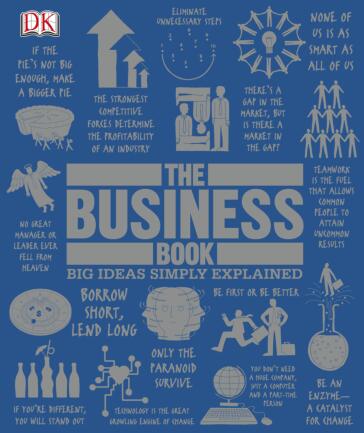THE BUSINESS BOOK 内容简介
How to build a successful brand? What makes a great business leader? Why are some companies can flourish, but some companies toward decline? Throughout history, business masters put forward many ideas and solutions, created the commercial version of the world. From risk management to the business model, from the leadership to the business strategy, the business data (full color) is the window of the world business, dialysis and present commercial derivative and development in human society, more covers all aspects of business management.
Book business encyclopedia (full color) language level, it USES accurately reveal the explanation of the top business ideas, analyze the complex business terminology, let readers understand the arcane business step by step with the chart theory, with a witty illustration shows a blend of business ideas with the international market.
Whether you are starting a business entrepreneur, CEO of hopes to expand field of vision, or interested in stimulating business development factors of consumers, you will get much inspiration from the book.
THE BUSINESS BOOK 精彩文摘
All businesses come from the same thing: an idea. How to deal with this idea determines the success or failure of the enterprise.
According to entrepreneur magazine, nearly half of the newly established businesses went bankrupt in the first three years. It is not easy to overcome the difficulties in the early days of its founding. First, no matter how good an idea is, it must be combined with entrepreneurship. The definition of entrepreneurship is willingness to take risks. Without entrepreneurship, great ideas may never be implemented. However, not every idea is a good idea; entrepreneurs will also be confused and rush products to market without careful thinking, research and detailed planning. For commercial enterprises, risk is inherent, but successful entrepreneurs not only dare to take risks, but also have the ability to manage risks.
Realistic proposition
One idea is the first step - the next obstacle is financing. Some new businesses need only a small amount of capital, and a few do not even need capital. However, many enterprises need a lot of financial support, and most of them need to find funds in the process of growth. Entrepreneurs have to convince investors that the idea is sound and that they have the skills and knowledge to transform the original concept into a successful company.
Thus, the idea must be profitable. Sometimes an idea looks good on paper, but it turns out to be unprofitable after it is put into practice. To determine whether an idea has potential, it is necessary to study competitive products and related markets. Who is competing for customers'time and money? Are competitors selling directly competitive products or possible alternatives? How did competitors react in the market? How big is the market?
Most markets are becoming more and more internationalized, crowded and competitive. A few companies are lucky enough to find a profitable niche --- if they want to succeed, they have to do something different to stand out in the market. Most businesses adopt a strategy of differentiation; this means that they show customers what competitors can't offer - Unique Selling Point (USP) or Emotional Selling Point (ESP).
This way of standing out can be seen everywhere. Every enterprise in every stage of production, from raw material extraction to after-sales service, is trying to distinguish its products or services from others. Walk into any bookstore and you will see countless examples of books. These books usually cover the same topic, but their design, style and even size (large or small) make them stand out from the competition.
Advantage usually depends on two things: being the first person to enter a new niche in the market, or being different in competition. For example, eBay was the first to enter the online auction market in 1995 and has been dominant ever since. Similarly, Volvo was the first to find sales opportunities for luxury buses in India, and its sales have been good. On the contrary, Facebook is not the first social network, but it is the most successful, with the advantage of having better products. Once an enterprise is established, its challenge will change: the goal becomes to maintain sales and grow in the short or long term.
Flexibility for survival
The long-term survival of enterprises depends on lasting remodeling and transformation, so as to maintain a leading position in the competition. The market is growing and evolving, full of variables. With the passage of time, the ideas on which the enterprise was founded will no longer apply, and the enterprise will inevitably be imitated by its competitors. The ecosystem in which enterprises operate will never be static. In this ecosystem, companies are like living creatures, and they have to adapt to survive. In their book Reinventing Giants, Bill Fisher, Umberto Lago and Liu Fang point out that Haier, a Chinese home appliance manufacturer, has undergone at least three remodeling in the past three decades. On the contrary, Kodak, an American giant in the 20th century, was slow to respond to the rise of digital imagery and ended in bankruptcy.
Not only that, business owners need to be flexible just like businesses. Most start-ups are small and remain small. A few entrepreneurs are willing and know how to take the second step: recruiting people who are not related to their families. This is the beginning of entrepreneurship into leadership. This requires a new set of skills and puts new demands on the founders of enterprises. With enough energy, thought and passion, the evolution of enterprises needs to develop formal systems, steps and processes. Simply put, enterprises need to be managed. Founders must have the skills of empowerment, communication and collaboration, or they must hire people with those skills.
Larry Greiner mentioned in his paper "Evolution and Change of Organizational Growth" that as enterprises grow, their requirements will change. Grayner curve shows that enterprises depend on individual initiative in the early stage of growth. Only experienced people and rigorous systems can turn temporary business practices into sustainable and successful growth. Professional management, contrary to entrepreneurship, has become the key to the evolution and development of enterprises.

→→→→→→→→→→→→→→→→→→→→查找获取




评论